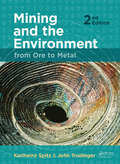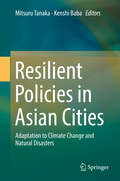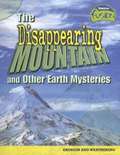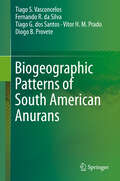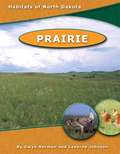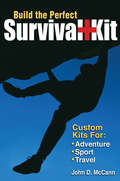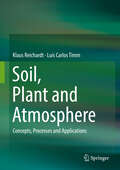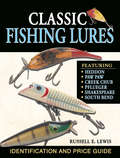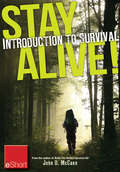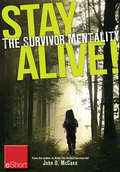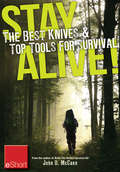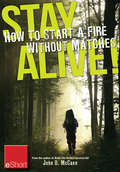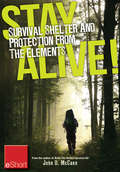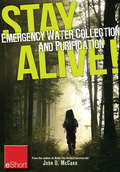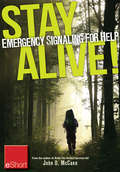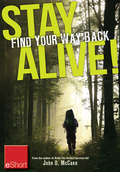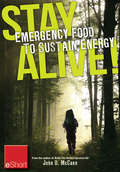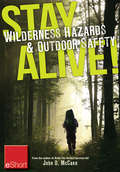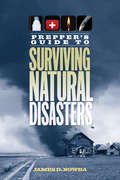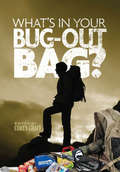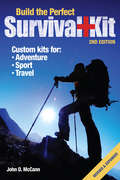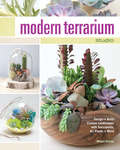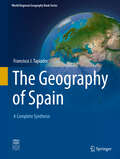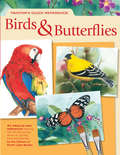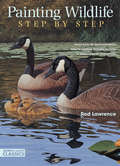- Table View
- List View
Mining and the Environment: From Ore to Metal
by Karlheinz Spitz John TrudingerThe history of mining is replete with controversy of which much is related to environmental damage and consequent community outrage. Over recent decades, this has led to increased pressure to improve the environmental and social performance of mining operations, particularly in developing countries. The industry has responded by embracing the ideals of sustainability and corporate social responsibility. Mining and the Environment identifies and discusses the wide range of social and environmental issues pertaining to mining, with particular reference to mining in developing countries, from where many of the project examples and case studies have been selected. Following an introductory overview of pressing issues, the book illustrates how environmental and social impact assessment, such as defined in "The Equator Principles", integrates with the mining lifecycle and how environmental and social management aims to eliminate the negative and accentuate the positive mining impacts. Practical approaches are provided for managing issues ranging from land acquisition and resettlement of Indigenous peoples, to the technical aspects of acid rock drainage and mine waste management. Moreover, thorough analyses of ways and means of sharing non-transitory mining benefits with host communities are presented to allow mining to provide sustainable benefits for the affected communities. This second edition of Mining and the Environment includes new chapters on Health Impact Assessment, Biodiversity and Gender Issues, all of which have become more important since the first edition appeared a decade ago. The wide coverage of issues and the many real-life case studies make this practice-oriented book a reference and key reading. It is intended for environmental consultants, engineers, regulators and operators in the field and for students to use as a course textbook. As much of the matter applies to the extractive industries as a whole, it will also serve environmental professionals in the oil and gas industries. Karlheinz Spitz and John Trudinger both have multiple years of experience in the assessment of mining projects around the world. The combination of their expertise and knowledge about social, economic, and environmental performance of mining and mine waste management has resulted in this in-depth coverage of the requirements for responsible and sustainable mining.
Resilient Policies in Asian Cities: Adaptation to Climate Change and Natural Disasters
by Mitsuru Tanaka Kenshi BabaThis book presents a comprehensive framework and indicators that can be used to assess a city’s degree of resilience. Based on surveys using bottom-up assessment tools, it proposes the concept, framework and indicators of a resilient policy model (including some participatory approaches). It also presents case studies of this and similar tools applied to Japanese and Asian cities, the highlights including information not previously available in English. Today, the term “resilience” is prevalent in the context of sustainable societies. The IPCC AR5 published in 2014 again stressed the impact of climate change on natural disasters, while in March 2015 at the World Conference on Disaster Risk Reduction, the United Nations International Strategy of Disaster Reduction (UNISDR) published the Sendai Framework for Disaster Risk Reduction Action 2015-2030 , which serves as a guideline for local governments. Offering transdisciplinary perspectives from fields such as policy science, urban planning, environmental science, social psychology, management development and geography, this book discusses the lessons learned from Asian case studies, explaining the challenges and the effectiveness of the tools, and offering transdisciplinary insights for policymakers.
The Disappearing Mountain and Other Earth Mysteries: Erosion and Weathering (Raintree Fusion: Earth Science)
by Louise Spilsbury Richard SpilsburyThe Earth's surface is changing all the time. In the past, people made up stories to explain these mysteries. Your mission is to find out the facts.
Biogeographic Patterns of South American Anurans
by Tiago S. Vasconcelos Fernando R. da Silva Tiago G. dos Santos Vitor H. Prado Diogo B. ProveteThis book analyzes different facets of anuran amphibian distribution in South America. We integrate alternative biological metrics employing cutting-edge methods to understand the dynamic processes underlying species distribution patterns. By using the modern biogeographic toolbox, we explore how richness gradients, phylogenetic diversity, functional diversity, and range size/endemism distribution of amphibians vary along the continent. Moreover, we present a robust proposal for priority areas for conservation of anurans in South America that maximizes representativeness of distinct biodiversity facets.
Habitats of North Dakota Prairie
by Gwyn Herman; Laverne JohnsonThe information presented in Habitats of North Dakota seeks to promote teaching and learning about the wildlife and conservation topics of North Dakota. Five separate units have been developed to discuss the habitats. They are Wetlands, Prairie, Badlands, Woodlands, and Riparian Areas.
Build the Perfect Survival Kit: Custom Kits for Adventure, Sport, Travel
by John MccannAn emergency can arise anytime. Now everyone from the average commuter to the risk-taking sportsman can benefit from these just-in-case kits that may just save a life. Build the Perfect Survival Kit offers a number of kits, from very basic pocket-sized ones with just the essentials to elaborate ones designed for weeks of surviving in the wilderness. The book advocates careful advance planning and building a personalized kit specifically tailored to each outing or possible emergency that may be encountered. Readers will learn about the eight categories of gear: Fire and Light, Signaling, Water and Food, Shelter and Protection, Knives and Tools, Multi-purpose Items and Miscellaneous Items, and what to pack into a kit for their pocket, glove box, four-wheeler, trunk, small plane, backpack, and more. ·Each kit is described with a list of components, a picture of the finished product, and a discussion of each component and its value ·Gives instructions on how to use each component ·Not just for hardcore outdoorsmen - this is valuable information for anyone who drives a car, walks in the woods, etc.
Soil, Plant and Atmosphere: Concepts, Processes and Applications
by Klaus Reichardt Luís Carlos TimmThis textbook presents the concepts and processes involved in the soil-plant-atmosphere system as well as its applications in the water cycle in agriculture. Although reaching the frontier of our knowledge in several subjects, each chapter starts at the graduation level and proceeds to the post-doctoral level. Its more complicated subjects, as math and physics, are well explained, even to readers not well acquainted with these tools. Therefore, it helps students read, understand, and developing their thoughts on these subjects. Instructors also find it an easy book with the needed depth to be adopted in courses related to Soil Physics, Agricultural Management, Environmental Protection, Irrigation and Agrometeorology. It serves also as “lexicon” to engineers and lawyers involved in agricultural, environmental cases.
Classic Fishing Lures: Identification and Price Guide
by Russell LewisCovering the collectible lures of the six most popular lure manufacturers in North America - Heddon, South Bend, Paw Paw, Pflueger, Creek Chub and Shakespeare, this full-color book is the most comprehensive identification and price guide available! This book features a history of each manufactures, with nearly 2,000 listings of the most collectible lures on the market, complete with up-to-date pricing and a brilliant color photos. No collector will want to be without this glorious tribute to the fishing lures of yesterday.
Stay Alive - Introduction to Survival Skills eShort: An overview of basic survival skills, kits, food, clothing & more.
by John MccannIn this excerpt from Stay Alive! Survival Skills You Need, John D. McCann introduces you to survival kits, survival clothing and basic skills to survive.
Stay Alive - The Survivor Mentality eShort: Learn how to control fear in situations by using the survival mindset.
by John MccannIn this excerpt from Stay Alive! Survival Skills You Need, John D. McCann tells you what types of fears you may feel in a survival situation and how to control those fears.
Stay Alive - The Best Knives & Top Tools for Survival eShort: Learn how to choose the ultimate survival knife & discover the best survivor too ls.
by John MccannIn this excerpt from Stay Alive! Survival Skills You Need, John D. McCann introduces you to the various types of knives and helps you choose the best survival knife.
Stay Alive - How to Start a Fire without Matches eShort: Discover the best ways to start a fire for wilderness survival & emergency prepa redness.
by John MccannIn this excerpt from Stay Alive! Survival Skills You Need, John D. McCann teaches you how to select a fire site and how to start and maintain a fire.
Stay Alive - Survival Shelter and Protection from the Elements eShort: Learn about your body#s thermoregulation, what protection it needs and how to bu ild a storm shelter for protection.
by John MccannIn this excerpt from Stay Alive! Survival Skills You Need, John D. McCann explains how the body loses heat and how a proper shelter helps prevent that loss.
Stay Alive! Emergency Water Collection and Purification eShort: Know where to find sources of water & purification methods to make it safe to dr ink.
by John D. MccannIn this excerpt from Stay Alive! Survival Skills You Need, John D. McCann shows you what can be used as a water container, where to find water, and how to purify water.
Stay Alive - Emergency Signaling for Help eShort: Learn survival techniques & tips with emergency devices to help know where you a re
by John MccannIn this excerpt from Stay Alive! Survival Skills You Need, John D. McCann tells you how to signal for help by using devices like mirrors, whistles, lasers and other signals.
Stay Alive - Find Your Way Back eShort: Learn basics of how to use a compass & a map to find your way back home
by John MccannIn this excerpt from Stay Alive! Survival Skills You Need, John D. McCann teaches you the basics of compass and map reading. He also describes types of maps and compasses and how they can be used to navigate your way back.
Stay Alive - Emergency Food to Sustain Energy eShort: Know what survival foods are most important to & other survival tips
by John MccannIn this excerpt from Stay Alive! Survival Skills You Need, John D. McCann tells you the best foods to bring into the field. If you have no food, he teaches you techniques to catch and cook food.
Stay Alive - Wilderness Hazards & Outdoor Safety eShort: Learn how to survive in the wild with wilderness first aid training and other ou tdoor survival tips
by John MccannIn this excerpt from Stay Alive! Survival Skills You Need, John D. McCann informs you of dangers, hazards and medical issues that you may encounter in a survival situation.
Prepper's Guide to Surviving Natural Disasters: How to Prepare for Real-World Emergencies
by James D. NowkaReal disasters - floods, fires, tornadoes, hurricanes, chemical spills - occur every year. Prepper's Guide to Natural Disasters skips the hype and hysteria of less likely, apocalyptic scenarios and helps you understand, prepare for, and survive real threats to your family and home - events that affect hundreds of thousands of people every year. The Prepper's Guide to Natural Disasters helps you assess the real threats in your part of the country, then provides clear, detailed solutions to help you prepare for and survive these events.
What’s in Your Bug Out Bag?: Survival kits and bug out bags of everyday people. (Survival & Preparedness)
by Corey GraffIn What's In Your Bug Out Bag?, you'll hear from 15 everyday people as they describe their actual bug out bag list - the ultimate 72-hour go-kit guide from and for real people. Get survival kit ideas and find out what first aid, shelter, navigation, food, water and personal protection items people are counting on to get to safety. Each bug out bag checklist is described and analyzed by our expert staff plus in the words of the people who assembled these bug out bags. If you're wondering how to make a survival kit or how to make a bug out bag you've come to the right place.In What's In Your Bug Out Bag? You'll Learn:Popular gear for bugging out and preppingHow to choose the best backpacks for bug out bagsHow to organize and prioritize gear for your bug out bag
Build the Perfect Survival Kit
by John D. MccannYour Kit, Your Survival When an unexpected emergency situation rears its ugly head, will you be up to the challenge? "I wasn't prepared for that!" will no longer be a valid response with the survival-kit-building methods in this book from survival expert John McCann. This fully revised and expanded second edition includes all new information for building bug out bags, get-home bags and vehicle kits that are fully customized to meet your family's specific survival needs. Inside you'll find: Advice for building complete kits that include: fire and light sources, signaling equipment, water and food, shelter and protection, knives and tools, first aid items, and multi-purpose and miscellaneous gear. Hundreds of detailed photos and gear description of essential kit components. Sample packing lists for kits of all sizes and functions. Survival tips and skills that prepare you for emergency survival situations. This book makes building the perfect kit a straightforward and manageable task--no matter what your activity. It is a must for anyone who ventures outside the home. Armed with the kit-building techniques found within, you will be prepared to survive!
Modern Terrarium Studio: Design + Build Custom Landscapes with Succulents, Air Plants + More
by Megan GeorgeGive terrariums a modern makeover! Clean lines and bold color: these aren't your average terrariums. Author Megan George presents 25 easy-to-make terrariums and living landscapes that push the boundaries of traditional terrarium design. From hanging brass himellis adorned with air plants to a wooden centerpiece bursting with succulents, you'll find creations perfect for placing in your home or office. Get creative with: Step-by-step directions for 25 air plant and succulent designs An overview of the author's favorite popular plants, including tillandsias, cacti, succulents, tropical plants and mosses Complete care instructions to keep your terrariums looking their best Planning a celebration? Take your terrariums a step further and incorporate them into your next party. Living letters make a charming, personalized piece at a wedding when used to spell the new couple's names. Turn your next summer picnic into a midsummer night's dream by hanging an air plant chandelier. No matter where you display them, these living landscapes will instantly give your space a whimsical, modern vibe.
The Geography of Spain: A Complete Synthesis (World Regional Geography Book Series)
by Francisco J. TapiadorThis book is the latest and most comprehensive reference to the regional geography of Spain, taking into account emergent issues such as biodiversity, climate change and nationalism. It appeals to scientists as well as to students and instructors and all fields of geography, regional, environmental and cultural studies, and business related disciplines. It covers the whole range of topics from the physical to the human geography of Spain and provides detailed insights into all 17 autonomous communities. Dozens of GIS maps and hundreds of photographs and images including remote sensing imagery make this volume a must have for every geography department.
Painter's Quick Reference Birds & Butterflies: Birds And Butterflies
by Editors of North Light BooksThe perfect reference for painters! Brighten your paintings with colorful birds and butterflies. Inside you'll find more than 40 step-by-step demonstrations to help you accurately render beautiful butterflies and a wide variety of songbirds, water birds and exotic birds including goldfinches, hummingbirds, cardinals, mallards and peacocks. You'll also learn how to embellish your paintings with individual feathers, eggs and a nest. This special guide features painting instruction and advice from 11 professional artists working in acrylics, watercolors, oils and colored pencils. Each demonstration includes a detailed materials list to make it even easier for you follow along. This invaluable combination of in-depth painting demonstrations and inspiring ideas is guaranteed to bring you success in all your work.
Painting Wildlife Step by Step: Learn from 50 demonstrations how to capture realistic textures in watercolor, oi l and acrylic
by Rod LawrenceEasy-to-follow, step-by-step demonstrations in acrylic, watercolor and oil Inside, you'll learn how to create realistic wildlife paintings, step by step, mastering dozens of specific wildlife textures, including: Fur of a bobcat, American bison, snow leopard cub and wolf Feathers of a wood duck, white-throated sparrow and northern shoveler Scales of a trout and sunfish Ears of a cottontail rabbit, white-tailed deer and red fox Bills and Muzzles of a northern cardinal, mallard, great blue heron and mountain lion Tails and Feet of a red squirrel, ruffled grouse and blue jay Antlers and Horns of a deer, moose, bighorn sheep and pronghorn White and Black Subjects such as a polar bear, tundra swan and Canada goose Through, you'll benefit from Rod Lawrence's years of wildlife painting experience. He'll help you notice, for example, the way hair and feature textures change on different parts of an animal's body through the seasons - and even according to the age of the animal. Use this heightened awareness, along with the easy-to-follow, step-by-step demonstrations inside, to create more realistic, more sensitive wildlife paintings.
